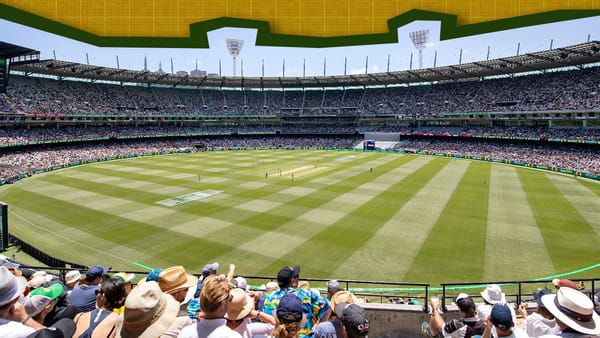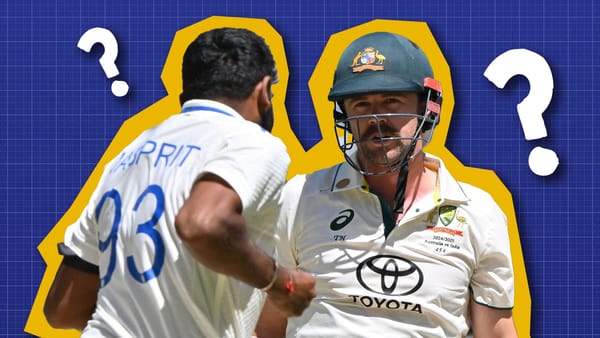Where cricket and baseball meet
Cricket and baseball have evolved very differently, but even now they still meet up on occasion.
The ball is thudding into the glove. One of the faster bowlers in the world is steaming with a wicketkeeper behind the stumps. Except you might have noticed I said glove, not gloves. The keeper or I suppose catcher, is Dave Nillson from the Milwaukee Brewers. In his last year in Major League Baseball would be an All-Star. The bowler was World Cup winner Craig McDermott.
Both were Australians and happened to share the same agent.
Nillson asked to take a few in the nets from McDermott, standing a metre back from the stumps, pouching balls cleanly from McDermott off his full run. In those nets, Nillson also showed McDermott a new delivery. The split-finger slower ball.
McDermott used it as his slower ball variation for a while, but Glenn McGrath perfected it. Even using it in Tests until batters started to work it out better.
If McGrath was Australia's greatest seam bowler, Fred Spofforth was their first great.
Despite growing up when underarm bowling was still common in Australia, he became one of the first great overarm bowlers. He saw the England bowlers try it and he would be one of the first to perfect it.
But he's generally remembered as one of the game's first swing bowler. Or as he called it, swerve. But Spofforth was also very intelligent, so he wanted to know why the ball was moving.
He went to scientists who told him that swing was an optical illusion and he shouldn't worry about it. But Spofforth knew the ball was moving, and what's more, he was talking about in swinging left, right, down and up.
So he went and watched baseball to learn more. He eventually thought that swing wasn't as important, partly because he thought you had to bowl too full to make it happen.

But think about this, Spofforth was looking at baseball in the 1880s for inspiration. So that's almost 150 years of Australian bowlers looking for tips from baseball pitchers.
Just after Spofforth, Cricket had a bowler who was also a great pitcher, from Philadelphia.
Baseball was as strong in Philadelphia as anywhere else, but cricket remained important. The Philadelphians also toured as the Gentlemen of Philadelphia, and when they did, they took with them one of the greatest and most underrated cricketers of all time, John Barton King. Bart.
King had moved to cricket as a young man and was instantly good at it. As a baseball pitcher, he knew how to deceive batters of either sport and by 18 was playing for the American national team. Like a pitcher, he covered the ball with his non-bowling hand as he came to the wicket, much like what bowlers do now with reverse swing, and he swung the ball a lot for his era.
The Australian squad to England in 1893 stopped in Philadelphia on the way back home. They played two matches, in the first they were hammered. First, when they bowled, Philadelphia made over 500, King, batting at 11 made 36, and then when he bowled, King took a five for. Everyone was shocked that a city from America could beat the Australians. The Australians did win the next match easily. These were King's first two first-class matches.
King would tour England in 1897 and take 72 wickets at 24. In 1903 it would be 78 at 16. And by 1908 it would be 73 wickets at 12. He did all of this while averaging 20 with the bat, and making a first-class hundred against Surrey. King was a player. Had he been born in Australia, England or South Africa, King would have been a Test player. In 1908 he was the best bowler in England.
CB Fry said he was "the best swerver I ever saw in my life". King took 415 first-class wickets at 15.66, which, according to David Mutton, "constituted 42% of his side's wickets."
Sadly when cricket finally died out in Philly, so did all US cricket, and also the legacy of this pitcher who bowled as good as anyone of his era.
It's worth talking about the cricketers who became baseball's here. That might be stretching it of Arjun Nimmala, who was recently a first-round draft pick in Major League Baseball. But his family is from India, and he would go there and play as a kid.
But there have been others. Ian Pont - now a fast bowling coach - went over to try out with the Philadelphia Phillies.
Former England Selector Ed Smith briefly tried to play baseball to right a book about it.
The West Indian Kieron Powell also had a crack at baseball but never made it.
And ofcourse a story really that kind of didn't exist, but did, is that a Red Sox Talent Scout - who happened to be the Australian baseball team coach - said that Adam Gilchrist could have come over to baseball during the 05 Ashes.
Of course, it has happened in the other direction as well, Former BlueJay Boomer Collins tried to come over to cricket.
Although perhaps the most interesting is Shogo Kimura. He played baseball in Japan for 30 years but then decided to shift to cricket as his other ball career ended. And he made it to the national team.
He even has his own YouTube channel following his rise in cricket. Compared to some baseballers playing cricket his technique is pretty sound. But obviously, he's a way off his goal of playing in the IPL.
Oh, and because it is the law to mention this story when talking about cricket and baseball, Don Bradman and Babe Ruth watched a game together once. Also, Ruth played cricket in the nets, he struggled with a normal technique and then just started baseball swinging the net bowlers everywhere.
I think the most interesting story is the weird story of how many Australian Test captains played baseball as a Kid. Essentially from 1968 until 1995 Australia had leaders who played baseball when they were growing up. Even Neil Harvey lead the team in '61. But Bill Lawry did, then did both Chappell brothers, and also Allan Border.

That is a bizarre run. And while baseball is probably bigger in Australia than other cricket nations, it is weird to think that so many captains played both sports as kids. I pose this question, is it possible that baseball is part of the reason Australia has traditionally been one of the best fielding teams?
Of course, in the late 90s the Australian team went from some amateur baseballers to the real thing when John Buchanan brought in the loud obnoxious baseball player - and now cricket coach - Mike Young to lead the team.
Shane Lee recently told the story on his site after one where Young made fun of Warne for being slow and throwing the ball too high on cricket connect.
""Hey Ricko (Mikey is now talking to Ricky Ponting), I watched you in the field. You're good man. And faster than Warno. Why do you walk in every ball in the field?"
In 20 years of my then cricket life, no one had ever asked the question. Why do we all walk in, in the field?"
Ofcourse Young wasn't the only one, Julien Fountain was a UK cricketer who tried to make it as a baseballer in the US, before representing the national team. But then he also became a fielding coach.
Through he also took it to another level by coaching the Korean Men's cricket team - who were all former baseballers.
Major League Baseball has tried to do the opposite as well, when the baseball agent J.B Bernstein thought that he could find a cricketer inside India and turn them into a Major League player. Weirdly he did find two guys, and they both made it to the pros before flaming out. One is a wrestler now.
But neither were actual cricketers.
It's also true that baseball missed some pretty big things from cricket.
Years ago I was sitting in the Lord's press box with ESPN Legend Wright Thompson when he was watching Sachin Tendulkar. Suddenly out of nowhere he said, "Oh, he's aiming the ball where he wants it to go".
That is not a baseball thing. You just hit it real hard mostly. But this is fun. Because we play cricket, I think we generally understand that the best way to set up a field, whether it be for someone doing it on purpose, or even by accident, is where players hit the ball.
Baseball did not do that. They put fielders in more or less the same pattern for generations. They might change it for a legend like Ted Williams. But mostly the fielders were left alone.
This is such a weird one for me, because if baseball had been paying attention to cricket, they could have started shifting decades earlier. Ofcourse players hit the ball to similar places repeatedly. Baseball should have shifted their field to have a deep midwicket and a mid on inside the ring years ago. Although by the time they worked this out, old baseball fans hated it and now they are not allowed to shift.
There is one other major modern crossover, cricket and baseball both have knuckleballs. Adam Holliaoke, who also bowled the split finger, would use the knuckleball in the 90s.
The version of Zaheer Khan, which was the first time the delivery started to be spoken of, comes from Charlie Langeveldt, who potentially got it from Jonathan Trott's half brother Kenny Jackson.
But the real change comes when bowlers like Benny Howell and Andrew Tye become more like knuckleball specialists. For Tye, he went from a club bowler on the fringe of pro cricket to a specialist with little known Graeme Cessford uggested the new delivery. It took Tye 3-5 years to perfect it. That one ball changed his life.
Then there is Benny Howell, who went from a bog ordinary six bowler of medium pace to one of the most destructive wicket takers in T20 after playing some baseball in Melbourne.
But the real difference between baseball pitchers who throw knuckleballs is that is pretty much all they throw. It's almost baseball's version of spin, except there are almost none of them. In fact, it was two years without a Knuckleball pitcher in the MLB.
Imagine us going a week of cricket without one. And our bowlers bowl a knuckleball and outswinger next ball like it's no problem. Knuckleball pitchers can't do that.
It may have something to do with the seams, or a bowling versus throwing action. But you do wonder what Major League pitchers who can throw at 100MPH could do if their changeup was a knuckleball.
And ofcourse now we have Major League Cricket, a league inspired in title by its baseball cousin. But even more than that, the major venue for the tournament and home of the final was in Dallas.
It used to be the home of the Texas Airhogs, an independent baseball team that folded during Covid.
For generations, cricket and baseball distanced themselves from each other. But professionalism and globalisation have brought that back together, one knuckleball at a time.




